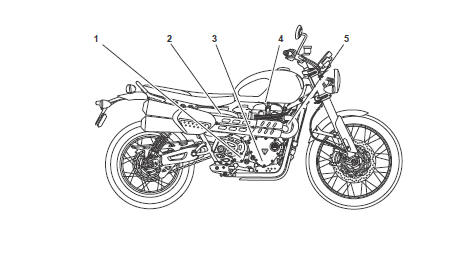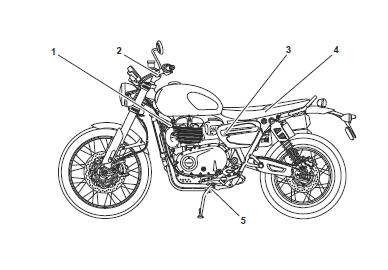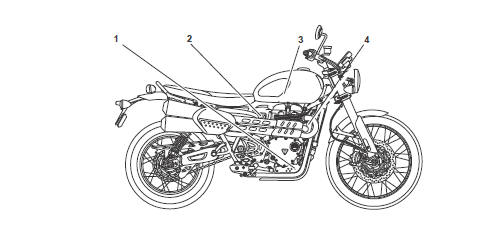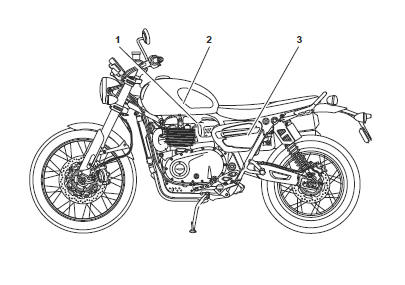 Triumph Scrambler 1200 XC - Service manual > Engine Management System
Triumph Scrambler 1200 XC - Service manual > Engine Management System
System Description
This model is fitted with an electronic engine management system which encompasses control of both ignition and fuel delivery. The engine electronic control module (ECM) draws information from sensors positioned around the engine, cooling and air intake systems and precisely calculates ignition advance and fueling requirements for all engine speeds and loads.
In addition, the system has an on-board diagnostic function. For additional information, see System Diagnostics.
System Sensors
- Intake air temperature sensor - situated on left hand side of the airbox. As the density of the air changes with temperature (therefore the amount of oxygen available to ignite the fuel), an intake air temperature sensor is fitted. Changes in air temperature are compensated for by adjusting the amount of fuel injected to a level consistent with clean combustion and low emissions.
- Ambient air pressure sensor - situated in front of the airbox. The ambient air pressure sensor measures atmospheric air pressure. With this information, the amount of fuel per injection is adjusted to suit the prevailing conditions.
- Manifold Absolute Pressure (MAP) sensor - situated below the fuel tank,
connected to the manifold by a length of tube. The MAP sensor provides
information to the engine ECM which is used at shallow throttle angles (very
small throttle openings) to provide accurate engine load indications to the
ECM.
This degree of engine load accuracy allows the ECM to make very small adjustments to fuel and ignition which would otherwise not be possible from throttle angle data alone.
- Clutch switch - situated on the clutch lever. The clutch must be pulled in for the starter motor to operate.
- Crankshaft position sensor - situated in the alternator cover. The crankshaft position sensor detects movement of teeth attached to the alternator rotor. The teeth give a reference point from which the actual crankshaft position is calculated. The crankshaft position sensor information is used by the engine ECM to determine engine speed and crankshaft position in relation to the point where fuel is injected and ignition of the fuel occurs.
- Engine coolant temperature sensor - situated at the front of the cylinder head near the thermostat housing. Coolant temperature information, received by the engine ECM, is used to optimise fueling at all engine temperatures and to calculate hot and cold start fueling requirements.
- Oxygen sensors - situated in the exhaust header pipe system close to the cylinder head. The oxygen sensors constantly feed information to the engine ECM on the content of the exhaust gases. Based on this information, adjustments to air/fuel ratio are made.
- Side stand switch - situated at the top of the side stand leg. If the side stand is in the down position, the engine will not run unless the transmission is in neutral.
- Fall detection switch - situated under the storage box. The fall detection switch will detect if the motorcycle is on its side and will cut power to the ignition and fuel systems immediately. This prevents the engine from running and the fuel pump from delivering fuel. In the event of a fall, the switch is reset by returning the bike to an upright position and switching the ignition off then back on again.
- Gear position sensor - situated in the lower crankcase, below the drive chain front sprocket. The gear position sensor provides the engine ECM with selected gear information. This is used to prevent the engine from starting if the transmission is in gear. The sensor also provides information to the neutral lamp in the instruments.
Sensor Locations

- Gear position sensor
- Intake air temperature sensor
- Crankshaft position sensor
- Manifold absolute pressure sensor
- Coolant temperature sensor

- Oxygen sensor
- Clutch switch
- Ambient air pressure sensor
- Fall detection switch
- Side stand switch
Actuators
System Actuators
In response to signals received from the sensors, the engine ECM controls and directs messages to a series of electronic and electromechanical actuators. The function and location of the actuators is given below.
- Throttle actuator motor - situated at the rear of the throttle body. The throttle actuator motor opens and closes the throttle plate in the throttle body, in response to commands from the engine ECM. The throttle actuator motor is an integral part of the throttle bodies.
- Canister purge valve (certain markets only) - situated In front of camshaft cover, attached to the frame. The purge valve controls the return of vapour which has been stored in the carbon canister during the period when the engine is switched off. The valve is 'pulsed' by the engine ECM to give control over the rate at which the canister is purged.
- Injectors - located in the cylinder head. The engine is fitted with two injectors. The spray pattern of the injectors is fixed but the length of time each injector can remain open is variable according to operating conditions. The duration of each injection is calculated by the engine ECM using data received from the various sensors in the system.
- Ignition coils - situated above the camshaft cover, attached to the frame. There are two coils fitted, one for each of the spark plugs. The engine ECM controls the point at which the coils are switched on and off. In calculating the switch-on time, the engine ECM allows sufficient time for the coils to charge to a level where a spark can be produced. The coils are switched off at the point of ignition, the timing of which is optimised for good engine performance.
- Main power relay - situated behind the left hand side panel. When the ignition is switched on, the main power relay is powered up to provide a stable voltage supply for the engine ECM.
- Fuel pump - situated inside the fuel tank. The electric pump delivers fuel into the fuel system, via a pressure regulator, at a constant 3.5 bar pressure. The pump is run continuously when the engine is operating and is also run briefly when the ignition is first switched on to ensure that fuel at 3.5 bar pressure is available to the system as soon as the engine is cranked. Fuel pressure is controlled by a regulator also situated inside the fuel tank.
- Cooling fan - situated behind the radiator. The engine ECM controls switching on and off of the cooling fan in response to a signal received from the coolant temperature sensor. When the coolant temperature rises to a level where the cooling effect of natural airflow is insufficient, the cooling fan is turned on by the engine ECM. When the coolant temperature falls sufficiently, the engine ECM turns the cooling fan off. The fan only becomes operational when the engine is running. It will not operate at any other time.
Note
In this system, the starter lockout system (clutch switch, neutral switch, side stand switch) all operate through the engine management ECM.
Actuator Locations

- Evaporative canister purge valve
- Throttle body motor
- Ignition coils
- Cooling fan

- Fuel injectors
- Fuel pump
- Main power relay
See also:
 Triumph Scrambler 1200 XC - Service manual > Fuel Requirements
Triumph Scrambler 1200 XC - Service manual > Fuel Requirements
Exploded Views Exploded View - Fuel Tank
 Triumph Scrambler 1200 XC - Service manual > Immobiliser and Keyless Ignition System
Triumph Scrambler 1200 XC - Service manual > Immobiliser and Keyless Ignition System
System Description This model is fitted with an electronic immobiliser and keyless ignition system to help protect it against theft. The immobiliser and keyless ignition system is incorporated in the keyless ECM. The keyless ECM has to be paired with the engine ECM and the ignition keys which each contain a transponder chip. If all the components are correctly paired, the immobiliser will allow the engine to start. These components can only be paired using the Triumph diagnostic tool..
 Ducati Scrambler
Ducati Scrambler Fantic Caballero 500
Fantic Caballero 500 Indian FTR 1200
Indian FTR 1200 Moto Guzzi V85 TT
Moto Guzzi V85 TT Royal Enfield Bullet Trials Works Replica
Royal Enfield Bullet Trials Works Replica Triumph Scrambler 1200 XE
Triumph Scrambler 1200 XE Triumph Street Scrambler
Triumph Street Scrambler Yamaha XSR700
Yamaha XSR700 Ducati Scrambler 800
Ducati Scrambler 800 Moto Guzzi V85 TT
Moto Guzzi V85 TT Triumph Scrambler 1200 XC
Triumph Scrambler 1200 XC